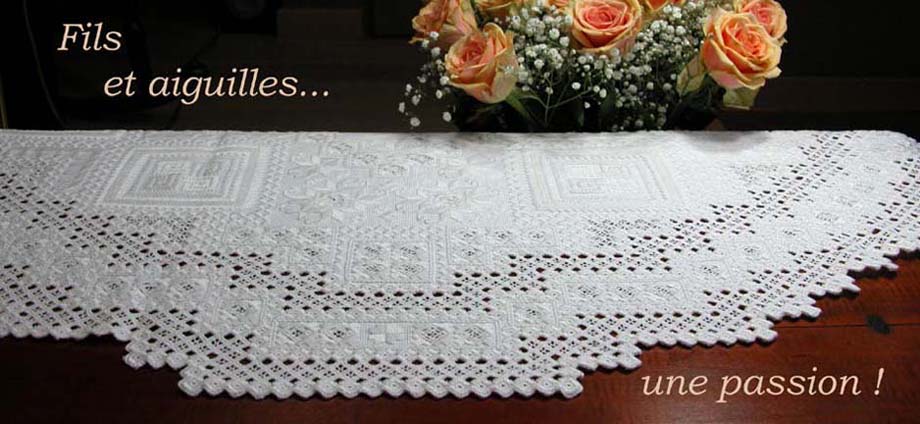Nous regardons maintenant un autre fragment de ma broderie lefkara en détail : le secteur 4/7 dans le schéma ci-dessous.
We now take a closer look at another fragment of my lefkara embroidery : sector 4/7 in the diagram below.
Deze keer bekijken we een ander gedeelte van mijn lefkarakleed in detail : sector 4/7 in het onderstaand schema.
La construction de cette zone triangulaire est tout à fait identique à celle du secteur 3/7, qui se trouve en position symétrique par rapport au centre de la broderie. Le seul élément par lequel les secteurs 3/7 et 4/7 se distinguent, se trouve dans la broderie lefkara dont sont remplis les carrés au passé plat. Ceci sera clairement illustré d'ailleurs par les photos en gros-plan dans cet article.
The construction of this triangular zone is completely identical to the one in sector 3/7, which stands in symmetrical position relative to the central part of the embroidery. The only distinction between sector 3/7 and 4/7 is in the typical lefkara embroidery used to fill the squares in satin stitch. This will be clearly illustrated by the close-ups in this post.
De opbouw van deze driehoekige zone is volstrekt identiek aan deze van sector 3/7, die zich in symmetrische positie bevindt ten opzichte van het centrale gedeelte van het borduurwerk. Het enige onderscheid tussen sector 3/7 en 4/7 zit hem in het typisch lefkara borduurwerk waarmee de vierkantjes in platsteek zijn opgevuld. Dat zullen de close-ups in dit artikel trouwens duidelijk illustreren.
Comme indiqué plus haut, les remplissages des carrés au passé plat de ce secteur-ci ne sont pas les mêmes que ceux utilisés dans le secteur 3/7. Les motifs en lefkara brodés ici s'appellent klonotée et vrangotée loxée. Je les ai placés en alternance.
As mentioned above, the fillings of the squares in this sector are not the same as these from sector 3/7. The lefkara motifs I embroidered here are called klonotée and vrangotée loxée, and they are placed alternately.
Zoals hierboven aangestipt werden in deze sector andere lefkara motieven gebruikt dan in sector 3/7 om de vierkantjes in platsteek op te vullen. De hier geborduurde motieven heten klonotée en vrangotée loxée, en wisselen elkaar af.
Tout comme dans le secteur 3/7 j'ai brodé une bande au point carré qui longe le cadre au passé plat. A côté de cette bande au point carré, ici aussi, un encadrement ajouré avec des barrettes au point de reprise et enrichi d'un double fil qui court à travers, tout en accentuant la forme triangulaire du secteur.
Just as in sector 3/7 I embroidered a strip in square stitch running along the frame that is filled with satin stitch squares. Next to this strip I here too carried out an openwork border in woven bars and enriched with a double thread running through that emphasizes the triangular shape of the sector.
Net zoals in 3/7 is naast de rij opgevulde platsteekmotieven een strook in hokjessteeek geborduurd. Daarnaast ook weer een opengewerkte rand in doorgestopte spijltjes met de doorheen lopende dubbele draad die de driehoekige vorm van deze sector accentueert.
Ensuite nous rencontrons le double bord pouvu de blouméezoun, cette broderie lefkara traditionnelle qui s'effectue toujours en forme triangulaire. Les motifs brodés ici sont les mêmes que ceux du secteur 3/7 : ziki-zaga dans le bord extérieur et lottoùthkia dans le bord intérieur.
Then we meet the double border worked with blouméezoun, that traditional lefkara embroidery which is always executed in triangular shape. The patterns that are embroidered here are the same as in 3/7 : ziki-zaga in the outer border and lottoùthkia in the inner border.
Vervolgens ontmoeten we de dubbele rand met de blouméezoun, het traditioneel lefkara borduurwerk dat altijd in driehoeksvorm wordt uitgewerkt. De hier geborduurde motieven zijn dezelfde als in 3/7 : ziki-zaga in de buitense rand en lottoùthkia in de binnenste rand.
A côté des blouméezoun : une rangée de petits cercles au point de feston, et finalement un petit triangle ajouré avec des barrettes enroulées et un double point d'esprit.
Beside the blouméezoun there is a row of small circles in buttonhole stitch and, finally, a small openwork triangle with woven bars and a double dove's eye.
Naast de blouméezoun een rij cirkeltjes in festonsteek en ten slotte een kleine opengewerkte driehoek met omwoelde spijltjes en een dubbele lussenspin.
Ci-dessous quelques photos supplémentaires du secteur 4/7.
Below some other photographs of sector 4/7.
Hieronder nog enkele detailfoto's van sector 4/7.
A suivre... To be continued... Wordt vervolgd...






























































